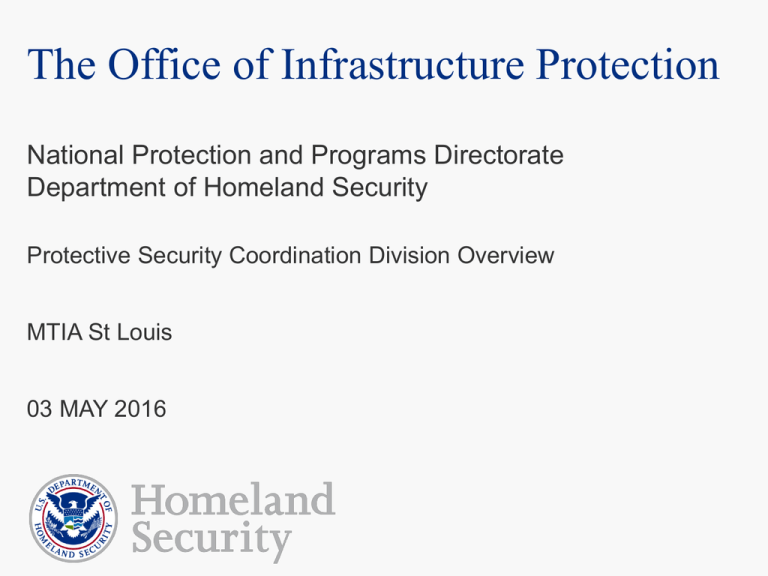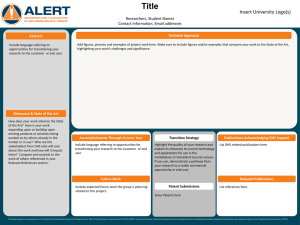Protective Security Coordination Division Overview
advertisement

The Office of Infrastructure Protection National Protection and Programs Directorate Department of Homeland Security Protective Security Coordination Division Overview MTIA St Louis 03 MAY 2016 Role of DHS Unify a national effort to secure America Prevent and deter terrorist attacks Protect against and respond to threats and hazards to the Nation Respond to and recover from acts of terrorism, natural disaster, or other emergencies Coordinate the protection of our Nation’s critical infrastructure across all sectors 2 Threats May Come from All Hazards Courtesy of FEMA 3 National Preparedness Goal Defines what it means for the whole community to be prepared for all types of disasters and emergencies The goal is “a more secure and resilient nation with the capabilities required across the whole community to prevent, protect against, mitigate, respond to, and recover from the threats and hazards that pose the greatest risk.” Courtesy of DHS 4 National Preparedness Goal (cont.) Organizes 31 core capabilities into 5 mission areas Prevention: Prevent, avoid, or stop an imminent, threatened, or actual act of terrorism Protection: Protect our citizens, residents, visitors, and assets against the greatest threats and hazards in a manner that allows our interests, aspirations, and way of life to thrive Mitigation: Reduce the loss of life and property by lessening the impact of future disasters Response: Respond quickly to save lives, protect property and the environment, and meet basic human needs in the aftermath of a catastrophic incident Recovery: Recover through a focus on the timely restoration, strengthening, and revitalization of infrastructure, housing, and a sustainable economy, as well as the health, social, cultural, historic, and environmental fabric of communities affected by a catastrophic incident 5 National Response Framework Guides how the Nation conducts all-hazards response Documents the key response principles, roles, and structures that organize national response Allows first responders, decisionmakers, and supporting entities to provide a unified national response Courtesy of DHS 6 National Infrastructure Protection Plan (NIPP) Comprehensive plan and unifying structure for the public and private sector to enhance the protection and resilience of critical infrastructure Partnership model Risk management framework Roles, responsibilities, and authorities Courtesy of DHS 7 NIPP (cont.) Drives internal Department of Homeland Security (DHS) programs and activities Guides programs and activities for: Other Federal agencies and departments State, local, tribal, and territorial governments Critical infrastructure owners and operators Courtesy of DHS 8 Presidential Policy Directive-21 Presidential Policy Directive-21: Critical Infrastructure Security and Resilience directs the Executive Branch to: Develop a situational awareness capability that addresses both physical and cyber aspects of how infrastructure is functioning in near-real time Understand the cascading consequences of infrastructure failures Evaluate and mature the public-private partnership Update the National Infrastructure Protection Plan Develop comprehensive research and development plan 9 Critical Infrastructure Defined “Systems and assets, whether physical or virtual, so vital that the incapacity or destruction of such may have a debilitating impact on the security, economy, public health or safety, environment, or any combination of these matters, across any Federal, State, regional, territorial, or local jurisdiction.” Source: National Infrastructure Protection Plan 2013 Courtesy of FEMA 10 Critical Infrastructure Sectors Chemical Commercial Facilities Communications Critical Manufacturing Dams Defense Industrial Base Emergency Services Energy Financial Services Food and Agriculture Government Facilities Healthcare and Public Health Information Technology Nuclear Reactors, Materials, and Waste Transportation Systems Water and Wastewater Systems Courtesy of DHS 11 Security and Resilience Challenges A majority of critical infrastructure is privately owned DHS has limited legal authority to regulate security practices of private industry Exceptions: National Protection and Programs Directorate Office of Infrastructure Protection (high-risk chemicals), Transportation Security Administration, and United States Coast Guard DHS; Sector-Specific Agencies; other Federal entities; the private sector; and State, local, tribal, and territorial governments all have roles and responsibilities in critical infrastructure protection 12 Protective Security Coordination Division Department of Homeland Security (DHS) Ensures a homeland that is safe, secure, and resilient against terrorism and other hazards National Protection and Programs Directorate (NPPD) Leads the national effort to protect and enhance the resilience of the nation’s physical and cyber infrastructure Office of Infrastructure Protection (IP) Leads the national effort to protect critical infrastructure from all hazards by managing risk and enhancing resilience through collaboration with the critical infrastructure community Protective Security Coordination Division (PSCD) Provides strategic coordination and field operations support to reduce risk to the nation’s critical infrastructure from a terrorist attack or natural disaster 13 PSCD Mission Areas Conduct Security Surveys, Gap Analysis, and Assessments Conduct Outreach Activities Support National Special Security Events (NSSEs) and Special Event Activity Rating (SEAR) Events Respond to Incidents Provide Improvised Explosive Device (IED) Awareness & Risk Mitigation Training 14 Protective Security Advisors PSAs are field-deployed personnel who serve as critical infrastructure security specialists Regional Directors (RDs) oversee and manage the PSA program in their respective region State, local, tribal, and territorial (SLTT) and private sector link to DHS infrastructure protection resources Coordinate vulnerability assessments, training, and other DHS products and services Provide a vital link for information sharing in steady state and incident response Assist facility owners and operators with obtaining security clearances During contingency events, PSAs support the response, recovery, and reconstitution efforts of the States by serving as pre-designated Infrastructure Liaisons (IL) and Deputy ILs at the Joint Field Offices 15 Protective Security Advisor Locations Courtesy of DHS 16 Protected Critical Infrastructure Information Established under the Critical Infrastructure Information Act of 2002 Protects voluntarily submitted critical infrastructure information from: Freedom of Information Act State and local sunshine laws Civil litigation proceedings Regulatory usage Provides private sector with legal protections and “peace of mind.” Courtesy of DHS 17 Examples of Critical Infrastructure Information Protected information defined by the Critical Infrastructure Information Act includes: Threats – Actual, potential, or threatened interference with, attack on, compromise of, or incapacitation of a critical asset Vulnerabilities – Ability to resist threats, including assessments or estimates of vulnerability Operational experience – Any past operational problem or planned or past solution including repair, recovery, or extent of incapacitation Any information normally available in the public domain will not be protected 18 Enhanced Critical Infrastructure Protection Visit Establishes and enhances DHS’s relationship with critical infrastructure owners and operators, informs them of the importance of their facilities, and reinforces the need for continued vigilance During an Enhanced Critical Infrastructure Protection (ECIP) visit, PSAs focus on coordination, outreach, training, and education ECIP visits are often followed by security surveys using the Infrastructure Survey Tool (IST) or Rapid Survey Tool (RST), or delivery of other IP services 19 Infrastructure Survey Tool The IST is a web-based vulnerability survey tool that applies weighted scores to identify infrastructure vulnerabilities and trends across sectors Facilitates the consistent collection of security information Physical Security Security Force Security Management Information Sharing Protective Measures Dependencies 20 Infrastructure Survey Tool (cont.) Generates the Protective Measures Index and Resilience Measurement Index The tool allows DHS and facility owners and operators to: Identify security gaps Compare a facility’s security in relation to similar facilities Track progress toward improving critical infrastructure security 21 Infrastructure Survey Tool (cont.) The Dashboards highlight areas of potential concern and feature options to view the impact of potential enhancements to protection and resilience measure The written report, developed from the IST data, contains a description of the facility and its vulnerabilities as well as recommendations to mitigate identified vulnerabilities Courtesy of DHS 22 IST Survey Data Categories Facility Information Security Force* Contacts Physical Security* Facility Overview Building Envelope Information Sharing* Delivery/Vehicle Access Control Protective Measures Assessment* Parking Criticality* Site’s Security Force Security Areas/Assets Intrusion Detection System (IDS)/Close Circuit Television (CCTV) Additional DHS Products/Services Access Control Criticality Appendix Security Lighting Security Management Profile* Images Cyber Vulnerability Dependencies* * Comparative analysis provided 23 Dashboards and Information Sharing Areas individually separated into Physical Security, Security Management, Security Force, Information Sharing, and Protective Measures. Owner/Operator can make adjustments and see improvements to individual area and overall Protective Measure Index (PMI). Greater understanding of the most significant changes and trends. Notional Information 24 Dashboard – Physical Security Example Notional Information 25 Computer-Based Assessment Tool Computer-Based Assessment Tool (CBAT) A data collection and presentation medium that supports critical infrastructure security, special event planning, and response operations by leveraging assessment data and other relevant materials Integrates assessment data with immersive video, geospatial, and hypermedia data Assists facility owners and operators, local law enforcement, and emergency response personnel to prepare for, respond to, and manage critical infrastructure, National Special Security Events (NSSEs), high-level special events, and contingency operations 26 Regional Resiliency Assessment Program The Regional Resiliency Assessment Program (RRAP) began in 2009 as a pilot program out of efforts to assess security of individual critical assets The goal is to identify opportunities for regional homeland security officials and critical infrastructure partners to strengthen resilience to all hazards The RRAP process identifies critical infrastructure security and resilience gaps; dependencies; interdependencies; cascading effects; and State, local, tribal, and territorial government capability gaps 27 Regional Resiliency Assessment Program (cont.) The RRAP process identifies critical infrastructure security, resilience, dependencies, interdependencies, cascading effects, and State, local, tribal, and territorial agency capability gaps Conducted 57 RRAP projects from Fiscal Year (FY) 2009 through FY 2015 Diverse and dynamic set of critical infrastructure topics, sectors, and regions 28 TRIPwire Technical Resource for Incident Prevention Secure information sharing platform for IED incident information, evolving IED tactics, lessons learned, and counter-IED preparedness information Builds knowledge and preparedness capabilities, filling vital gaps in information sharing Courtesy of TRIPwire 29 Counter-IED Training & Awareness Diverse curriculum of training designed to build counter-IED core capabilities, such as: IED Counterterrorism Detection Surveillance Detection Bomb Threat Management Vehicle-Borne IED (VBIED) Detection Protective Measures IED Search Procedures Increases knowledge and ability to detect, prevent, protect against, and respond to bombing threats Courtesy of DHS OBP 30 Counter-IED Training & Awareness Bomb-Making Materials Awareness Program (BMAP) Joint DHS-FBI program that promotes private sector point-of-sale awareness and suspicious activity reporting to prevent misuse of dual-use explosive precursor chemicals and components commonly used in IEDs Increases prevention opportunities by building a network of aware and vigilant private sector partners Courtesy of DHS/FBI 31 NCCAD National Counter-IED Capabilities Analysis Database The counter-IED capability and readiness assessment program uses a consistent, repeatable analytical methodology, field surveys, and web-accessible database for Bomb Squads, SWAT, Explosive Detection Canine Teams, and Public Safety Dive Teams Courtesy of NCCAD Increases knowledge of counter-IED capabilities at the unit, State, regional, and national-level in relation to relevant local or national preparedness goals Over 1,500 units assessed since 2005 32 NCCAD (cont.) Case Study: NCCAD Use by the State of New York (NYS) NYS mandated use of NCCAD in Homeland Security Grant Program justifications: 2008, Bomb Squads 2011, Explosive Canine Detection Teams 2013, SWAT Courtesy of New York State Homeland Security and Emergency Services NYS’s NCCAD strategy addresses counter-IED capability gaps and directs investments on a State-wide basis Courtesy of FBI Other states are looking to NYS as a model 33 MJIEDSP Multi-Jurisdiction IED Security Planning A systematic process fusing counterIED education, capability analysis, training, and planning tailored to the unique requirements of high-risk jurisdictions providing: Enhanced multi-agency, multijurisdiction IED prevention, protection, and response capabilities Integrated with National Preparedness System, including grant process and regional planning Courtesy of DHS OBP Over 75 workshops with after-action reports since 2007 34 Homeland Security Information Network (HSIN) HSIN (https://hsin.dhs.gov/) is DHS’s primary technology tool for trusted information sharing HSIN – Critical Infrastructure (HSIN-CI) enables direct communication between: DHS Federal, State, and local governments Critical infrastructure owners and operators Content includes: Planning and Preparedness Incident Reporting and Updates Situational Awareness Education and Training 35 InfraGard https://www.infragard.org InfraGard is an information-sharing and analysis effort serving the interests of and combining the knowledge base of a wide range of members At its most basic level, InfraGard is a partnership between the Federal Bureau of Investigation (FBI) and the private sector InfraGard is an association of businesses, academic institutions, State and local law enforcement agencies, and other participants dedicated to sharing information and intelligence to prevent hostile acts against the United States 36 Infrastructure Protection Report Series Increase awareness of the infrastructure mission and build a baseline of security and resilience knowledge throughout the Nation Identify Common Vulnerabilities, Potential Indicators of Terrorist Activity, and associated Protective Measures, along with actions that can be undertaken to enhance resilience Courtesy of DHS 37 Summary Facilitate local field activities in coordination with other DHS offices Provide partners with effective vulnerability and gap analyses, bombing prevention capability analyses, and the development of protective measures to identify emerging needs and areas for investment Through data collection, assessment, and analysis, DHS can generate products for Federal, State, and local officials and private sector owners and operators that drive initiatives, such as infrastructure protection grant programs and research and development requirements 38 How Can You Help? Engage with PSAs and other partners on critical infrastructure protection programs and initiatives Encourage participation in efforts to identify, assess, and secure critical infrastructure in your community Communicate local concerns related to critical infrastructure protection Enhanced security and resilience depends on developing and strengthening partnerships between all entities with a role in critical infrastructure protection 39 For more information, visit: www.dhs.gov/critical-infrastructure Ricky D. Goins Protective Security Advisor ricky.goins@hq.dhs.gov 573.469.1960


